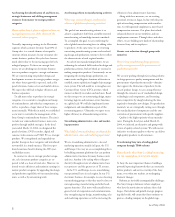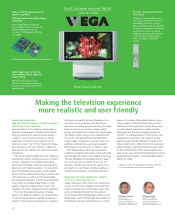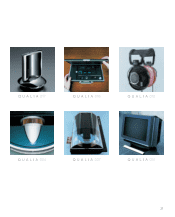Sony 2004 Annual Report Download - page 20
Download and view the complete annual report
Please find page 20 of the 2004 Sony annual report below. You can navigate through the pages in the report by either clicking on the pages listed below, or by using the keyword search tool below to find specific information within the annual report.
18
Cell: The next generation, multi-purpose microprocessor
To reinforce its competitive strength in its core electronics business, Sony is seeking to differ-
entiate its products by implementing a vertically integrated business model that incorporates
internally produced proprietary semiconductors, modules and components. Key components
include Cell, a next generation, multi-purpose microprocessor; imaging components, such as
CCDs and CMOS image sensors; display components, such as LCDs and organic electrolumi-
nescence (OEL) displays; Memory Stick; optical devices; and lithium-ion batteries. These
components are essential for producing highly competitive products.
The future of key components
Differentiating products by strategic
component
Over the years, Sony’s ability to develop such
proprietary key components as Trinitron and
CCD internally has been instrumental in creat-
ing numerous appealing products, and has
been the foundation of Sony’s evolution.
PlayStation 2 (PS2), for example, features the
EmotionEngine (EE), a 128-bit CPU incorporat-
ing highly advanced technology, and the
Graphics Synthesizer (GS), a high performance
image processor. Since its debut, PS2 has
revolutionized the game console market. As
the vital role played by EE and GS in the
success of PS2 showed, highly differentiated,
advanced semiconductors are essential in order
to open up new markets. Currently, Sony is
developing a new microprocessor, Cell, which
is ideally suited for the upcoming era when
the proliferation of broadband networks will
enable people everywhere to enjoy high-
resolution images.
The heart of next generation digital
consumer electronics
The concept behind Cell is to evolve the con-
ventional microprocessor, which is more of a
narrowband data processor that computes text
and still images mainly for PCs into a broad-
band data processor for game consoles and
high-definition televisions. Connecting several
multiple processors using a home network or
an IP broadband network will create a process-
ing capability that far exceeds that of a single
processor. The name Cell reflects Sony’s belief
that stand-alone microprocessors will be con-
nected through a broadband network and will
evolve to become a single global processor, in
the same way as organic cells combine to
create a living organism. Accordingly, network-
enabled devices, including consumer electron-
ics equipped with Cell, will become a structural
element of the broadband network itself.
Strategic alliance with IBM and Toshiba
expedites the development process
In March 2001, the Sony Group reached an
agreement with IBM Corporation and Toshiba
Corporation to collaborate in research and
development to create the architecture for a
new microprocessor, Cell, which it envisions as
the foundation of the next generation broad-
band network era. Combining their respective
strengths and technologies, the three compa-
nies expect to invest more than $400 million in
this project over five years. By incorporating
several of today’s most advanced semiconduc-
tor manufacturing technologies, such as cop-
per interconnects, a silicon-on-insulator (SOI)
process and low-K dielectric material, the
project aims to create a microprocessor that is,
in effect, a supercomputer on a chip.
Investment to facilitate production of
semiconductors for 65 nanometer process
technology—the most advanced in the world
Preparations are under way to fabricate Cell
and a variety of media processors in three
locations: Sony’s Nagasaki Fab; an IBM manu-
facturing facility in East Fishkill, New York; and
a Toshiba manufacturing facility in Oita, Japan.
In the fiscal year ended March 31, 2004, the
Sony Group recorded capital expenditure of
about ¥69.0 billion for the first stage of
construction of a mass-production facility for
semiconductors that use 65 nanometer (one
nanometer equals 1/1,000 of a micrometer)
process technology. Additional capital expendi-
ture of about ¥120.0 billion is planned for the
second stage of construction, beginning in the
fiscal year ending March 31, 2005. Trial opera-
tions at each of the three locations are sched-
uled to commence during the first half of
2005. Combined monthly production capacity
of the three facilities for 300mm wafers is
expected to be approximately 15,000 wafers.
























